

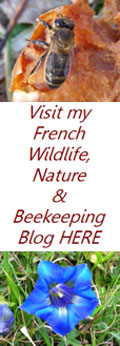

Stag beetle, Rose Chafer & Cock Chafer
Lucanus Cervus
is the largest European beetle, the Stag Beetle, or as they are
called in French “Le Lucane Cerf Volant”.
From around the
beginning of June on warm evenings in France, often when humidity
is high, we start to hear the drone of the males as they
make their clumsy and apparently impossible flights to seek out
the females. The females don’t fly as often as the males, (if at
all), tending to spend more of their time on the ground waiting
for the males to find them. Sometimes more than one male will
arrive attracted by the females pheromones, the males then proceed
to “fight for the right” using their large antlers to wrestle with
which happily rarely causes any harm as the weakest backs down and
retreats from battle.
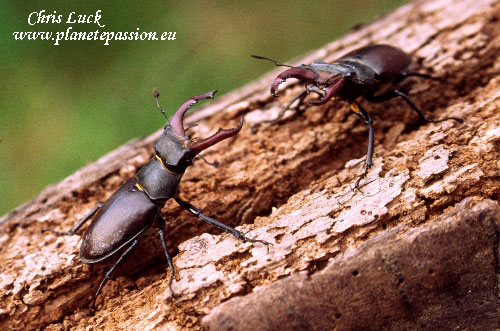
Photo above of two male Stag beetles facing each other.
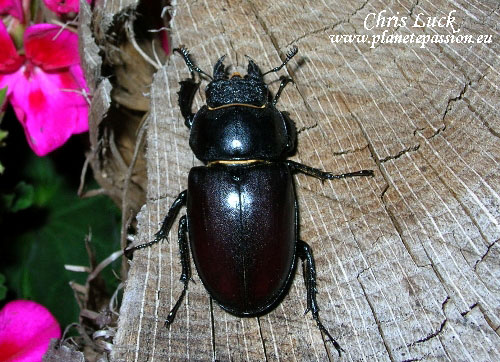
Photo above of a Female Stag Beetle
After copulation has taken place the female lays her eggs on what
is to be the food medium for the larvae. This is old, rotten wood
lying on the ground or at the base of dead or partly dead trees,
and although there is a preference for oak or chestnut other
timbers will be used. The
Stag beetle larvae, which can grow to a staggering 8cm and can
also “nip”, live in the rotting wood for many years. The
actual length of the life cycle is quite variable, possibly
dependent on temperatures and can be 4, 5, 6, 7 or even 8 years
resulting in a kind of insurance policy against bad years as well
as providing genetic variety. They are classed as saproxylophages,
creatures which live in dead and rotting wood.
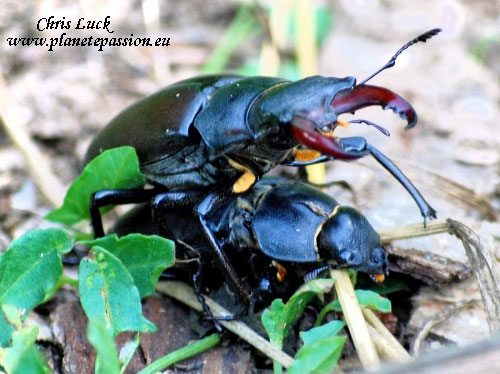
Photo above of a pair of Stag Beetles mating.
In most of the regions of France the
Stag Beetle is doing reasonably well although overall in
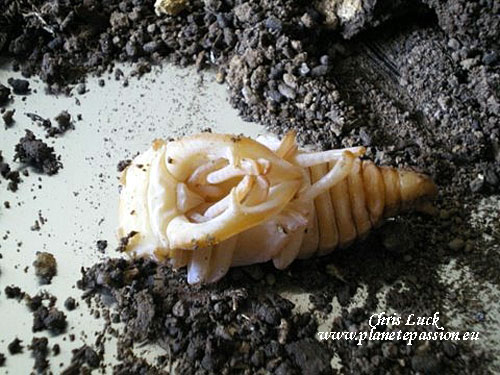
Another creature that buzzes loudly around our French gardens on
long, hot summer days is the stunning Rose chafer and surely
everyone has seen them; metallic green, bronze, blue or purple
splashed with a few little white spots or dashes. Nature has a way
of creating the most amazing colours.
The adult beetles that are
about 20 mm long are to be seen clinging to flowers where they eat
pollen and nectar and generally rummage around, something rose
lovers can get a bit heated about although in reality many other
flowers are visited, with native species such as thistle and
bramble being favoured. However it’s the larvae that cause most
concern and they are a continual source of confusion and
misunderstanding for people that mistake them for the larvae of
the Common Chafer or May bug as many will know them, (or indeed
for Stag beetle larvae). To get to grips with this we need to
understand their different biology and life cycles.
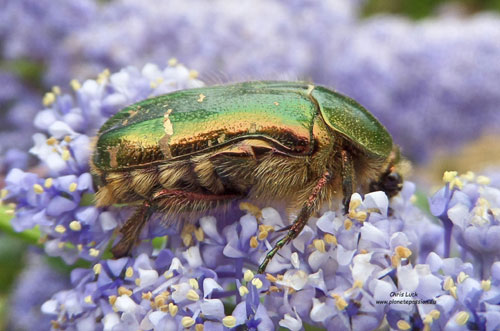
Following mating the female
Rose Chafers lay their eggs in decaying organic matter and then die.
This is why people find the grubs in their compost heaps and
sometimes in plants, shrubs and trees that are purchased in pots.
The larvae spend their lives and develop where the eggs have been
deposited which will be in compost, manure, leaf mould, and
occasionally well rotted wood where they are the equivalent of
earth worms and help break things down so in this respect
they are very beneficial.
They don’t eat living roots, only decomposed or decomposing
vegetative matter. They grow very quickly and will have moulted
twice before the end of autumn. They have a two-year life cycle
and they pupate in June or July of the second year when it’s
possible that some adult beetles may emerge in autumn, but the
main emergence is the following spring and early summer, when the
beetles mate.
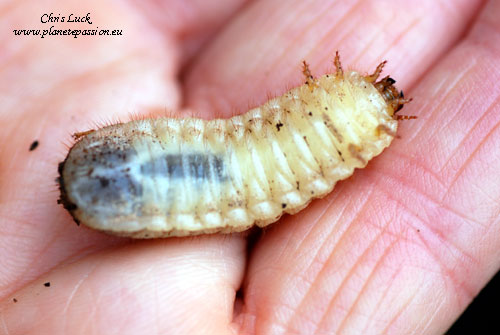
Cock Chafer adults emerge in April / May and live for perhaps 6
weeks although frequently less. During this time they mate and
females then bury their eggs about 10 to 20 cm deep in the soil in
different places with up to 80 or so in total. What’s important to
understand here is that the
Cock chafer eggs are usually laid in undisturbed old unmanaged
grassland in poor soil. This can lead to problems where they
are present when old grassland is initially converted into
vegetable beds where they may eat roots.
The larvae are polyphagous; they attack the roots of various
plants including potatoes, meadow grasses and trees.
In fact historically they
were a major agricultural pest and following the use of vast
quantities of pesticides including DDT and Lindane their numbers
have been drastically reduced and they are completely absent in
many areas. Mercifully these pesticides have been banned now in
the EU as have all applications of pesticides that function in the
soil and numbers are slowly increasing. The larvae once hatched
develop in the soil where they eat roots for 3 to 5 years at which
point pupation takes place in the autumn and the adults emerge the
following year.
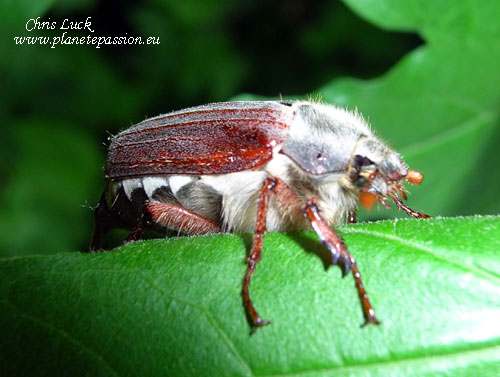
So how do you as a gardener know which big fat juicy creamy white
grub, (larvae), is which? Visually there isn’t a great difference
between the three of them unless you are going to look closely
which I suspect most people won’t BUT we can make it simple and
more or less foolproof and if you bookmark this you can refer to
it in the future.
Stag beetle grubs or larvae are 99% certain to be found in rotted
or rotting wood; normally this is quite large branches or trunks
that are on or partly in the ground where they remain constantly
wet or damp.
Rose chafer grubs are 99% certain to be found in compost, leaf-mould,
manure heaps and fibre rich soils. Occasionally they can be found
in the same habitat as Stag beetle larvae where the wood is
extremely degraded. They are frequently blamed for the death of
plants in pots because people think they eat the roots – they
don’t. What can happen is that they eat the compost and there
isn’t enough nutrition left for the plant but this only happens
when the plant is in too small a container.
Cock chafer grubs are always to be found in ordinary soil, usually
lawns and grassland, but remember they are quite scarce or rare in
many places and they are never to be found in decaying wood or the
compost heap.
As a final point, none of these large larvae can be confused for
being vine weevil larvae that can sometimes be found in the roots
of plants. Vine weevils
grubs are really quite small being no more than 10mm at the most.
Some general conservation advice:
If you have veteran trees, try to leave them standing, or if you
do need to cut down trees, try to leave the stumps in place to
decay. Try to maintain a native species hedge if you have one, or
if you have land consider planting a native species hedge. Make a
log pile in a corner of your garden, perhaps by sparing a few
lengths of oak from your firewood delivery if you have one and add
to it each year allowing it to slowly rot; the addition of bark,
wood chippings and sawdust will be useful, it is important that
the bottom remains in contact with or slightly buried in the soil.
This can be discreetly hidden behind a bush or shrub or made into
a decorative garden feature for those with an artistic leaning.
You could perhaps also empty all your grass cuttings in a heap
alongside your “wood pile”.
All of these measures will benefit many other species and
encourage biodiversity and add to the buzz in your garden.
It should be made absolutely clear that none of these larvae pose
any threat whatsoever to dry seasoned wood in your buildings; only
moist decomposing wood will be used outside on the ground.